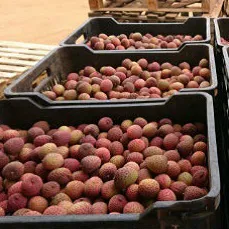The tale of the 2019/2020 South African litchi season isn’t a happy one, which is a real pity as there was a good crop on the trees, notes Pierre Pieters of Core Fruit. “But then six days of temperatures past 40°C and humidity as low as 10% about a month ago really roasted the fruit.”
A maximum temperature of 46°C was recorded in the Lowveld during that period.
“There’s no doubt that due to inadequate volumes some retail programmes in Europe will be short on litchis,” he adds.
Sunburn in the early Malelane and the later Tzaneen areas has been enormous, confirms Ben Halliday of Agrilink, airfreight provider for litchis to the USA. The “hectic” sunburn, to quote yet another litchi trader, was followed by much-appreciated rain, about a 100mm in total in the Tzaneen area (with persistent, days-long rain like the Cape’s rain), followed by more heat and then, splitting fruit.
In the Tzaneen area some litchi blocks have lost 60%, even 70% of fruit, due to sunburn and fruit splitting.
Moreover, fruit was early, 14 days to as much as 20 days in late areas, and so whereas usually traders can extend the litchi season to week 3 or 4, this year they say they’ll just make it past Christmas.
Looming European shortage The first vessel with fruit from Madagascar arrived in Europe at the beginning of the month, earlier than usual and therefore not full to capacity in an attempt to dock before the start of the French strike. The second vessel is due to arrive later this week, bringing high volumes to make up for the first.
The first vessel with fruit from Madagascar arrived in Europe at the beginning of the month, earlier than usual and therefore not full to capacity in an attempt to dock before the start of the French strike. The second vessel is due to arrive later this week, bringing high volumes to make up for the first.
Reports indicate better quality on the Malagasy litchis than last year, South African traders say.
“The volume from South Africa is significantly lower than normal,” Pierre says. “The early market should be stable but later a definite shortage will develop, the result of an undersupply during the later market from week 1 onwards.”
He continues: “My hunch is that prices might come down with week 52 arrivals, but as soon as the market realises that there’s a shortage the price will move to higher values.”
Debut season of Rhino Lychee
In the USA, where 80% or more of South African litchis ultimately go to customers of Southeast Asian descent and where the ideal is to time the arrival close to Chinese New Year (25 January) fruit could probably be stored until that time, the quality is certainly good enough, Ben Halliday notes.
“Feedback on our Rhino Lychee brand, which we launched this year in the USA, has been very positive. We’ve sent 150 tonnes at this point (35,500 cartons of 4.5 kg), which is about 8,500 cartons more than last year this time because the fruit is early, but overall we’ll probably end around 2,500 fewer cartons that we’d estimated.”
 Rhino Lychee, South African litchi brand for the US market (photo: Ben Halliday)
Rhino Lychee, South African litchi brand for the US market (photo: Ben Halliday)
“I’m very satisfied with the season,” he continues. “Despite the sunburn and the early start to the season, we’ve seen a virtually negligible level of spoilage, plus better colour development than during previous years. Eating quality is excellent, and the market feedback echoes that.”
Litchis exported to the USA are treated with sulphur and irradiated at Gateway America in Gulfport, Missississippi and from there distributed across the country to Miami, Boston, Chicago, New York, and the West Coast, specifically Los Angeles, which considerably adds to the logistics costs. The Rhino Lychee growers have partnered with Seasons Farm Fresh in the USA and they’re intent to grow the market when the shipping protocol has been finalised.
For more information: Pierre Pieters
Pierre Pieters
Core Fruit
Tel: +27 21 863 6300
pierre@corefruit.com
http://www.corefruit.com/
 Ben Halliday
Ben Halliday
Agrilink
Tel: +27 11 390 2366
ben@agrilink.co.za
http://www.agrilink.co.za/
